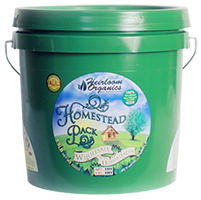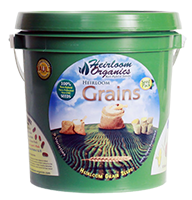|
Home > Guides > Grains > Wheat |
|
How to Grow Wheat | Guide to Growing Wheat |
|
|
|
|
| |
 |
|
Overview |
|
|
|
|
|
| |
|
| |
Wheat is one of the world's most important food crops. It is believed that wild relatives of wheat first grew in the Middle East. Wheat was one of the first plants to be cultivated. It was grown about 11,000 years ago.
Enormous changes in people's lives occurred because of wheat being grown. People began growing their own food and no longer needed to wander in search of food. Permanent settlements were established because wheat provided people with a stable food supply. Soon people grew enough wheat to feed people from other lands. Once there was extra wheat available, trade between various cultures developed.
By 4,000 B.C. wheat farming had spread to Asia, Europe and North Africa. New species of wheat developed because early farmers probably selected kernels from their best wheat plants to use as seeds for planting the following year's crop. That way, only the best wheat qualities were passed from one generation to the next. Soon wheat became an important world wide crop
Growing grains is easy and fun! Buy heirloom grain seeds here and start today! See our complete grain growing guide here. Did you know that most grains can be sprouted for high-nutrient super-foods? Try our sprouts packs here with the 3-Day Independence Sprouts Pack. Getting cabin fever? Can't wait to get to that Spring gardening? Grow indoors right now with the Complete Micro Greens Growing Kit or the Micro Greens Seed Pack. Have a high nutrient vegetable garden on your windowsill this week!
|
|
| |
|
|
| |
Growing Guide
GROWING NOTES
Prepare the area selected to grow wheat. If the field has been previously used for farming purposes, smooth the soil with a rake. Dig long trenches using a shovel or rent a commercial wheat drill attached to a tractor to plow the field and dig long narrow furrows.
Use a moderate quantity of a natural manure to fertilize the soil and ensure proper growth of the wheat stalks. Throw wheat seeds in the furrows using a semi circular movement of your wrist or attach a grain drill to a tractor to plant the seeds. For a dry area, sprinkle a small quantity of seeds. A heavily cultivated wheat uses up the water in the ground more quickly.
Water the field two to three times during a dry summer season. Winter wheat crops require water only when the seeds are planted. Wheat grows best in a dry climate; however, check the soil moisture of the winter crop at the start of spring and water if the wheat stems look parched and unusually dry. Consider irrigating the cultivated land by using commercial sprayers on wheels.
Monitor the wheat field regularly. Use a scythe to cut the wheat kernels once the wheat stems turn yellow and the kernels are fully dried up. Or use a "combine" machine to cut off the crop in a neat quick manner.
MAINTAINING
Water the wheat seeds immediately after planting and once each month during the growing season. If your area gets a lot of rain, you might not need to water the plants at all.
Place several plastic flags or streamers throughout your wheat patch. The noise made by the plastic blowing in the breeze deters birds from landing and scares off any birds that are already in the field. This will prevent birds from eating the wheat seeds before they have an opportunity to sprout.
Nourish the wheat with an all-purpose fertilizer twice during the growing season.
|
|
| |
|
| |
Heirloom seeds are the gardeners choice for seed-saving from year-to-year. Learning to save seeds is easy and fun with these books. Before you harvest, consider which varieties you might want to save seeds from so that your harvesting practice includes plants chosen for seed saving. Be sure to check out our newest seed packs, available now from Heirloom Organics. The Super Food Garden is the most nutrient dense garden you can build and everything you need is right here in one pack. The Genesis Garden s a very popular Bible Garden collection. The Three Sisters Garden was the first example of companion planting in Native American culture. See all of our brand-new seed pack offerings in our store.
|
|
| |
|
|
| |
Harvesting Guide
HARVESTING
Check to see if the wheat is mature enough to harvest. Wheat is usually harvested from spring to early summer, depending on the weather. To test the crop, rub the wheat head between your fingers and chew on a piece of grain. If the grain cracks in your mouth and becomes soft as you chew, it is ready to be harvested.
Prepare a place for your harvested wheat before you begin the harvest. If you plan to keep it on the farm, choose a location away from livestock that is weather resistant. Clear away anything that is left over from the last crop that was stored in the area. Keep the area cool and dry to maintain the wheat's freshness and keep away pests.
Adjust the combine that you use to harvest the wheat. Read the owners' manual that came with the combine to see how to adjust the settings for your wheat crop. Check the sickle and make sure it is sharp enough for a clean cut.
Plan to harvest the highest quality wheat first. Save the fields that have many weeds for last, as the wheat yield is much lower.
Take the freshly harvested wheat to a local grain elevator as soon as possible after harvest.
SAVING SEEDS
Collect seed heads as they dry on the plants and store in closed paper bags to finish drying (many of the seeds
will shed naturally). Chaff easily blows away after seed heads are crumbled (watch for thorns or prickles in some
plants).
|
|
| |
|
|
|
| |
|
|
|
|
|
| You can find this variety in the following Seed Packs: |
|
  
  |
|
| Click the packs below to see some of our other wonderful products |
|
|
|
|
|
|
|